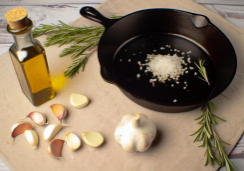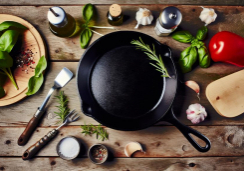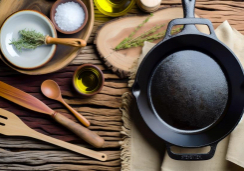9 Best Gluten-Free Baking Tips and Delightful Recipes
As you wind your carriage down the gluten-free baking path, remember that the journey is as rewarding as the destination. You've likely faced the challenge of creating baked goods that match the texture and taste of their gluten-containing counterparts, yet here you stand, ready to tackle it with finesse.
With these nine essential tips at your fingertips, you'll learn to master the art of gluten-free flours, understand the importance of hydration and resting, and discover the secret to perfect temperatures that could make or break your creations.
But don't think this guide stops at the mere essentials; you'll also explore how to craft delightful recipes—from the fluffiest quick breads to the most decadent cakes—that promise to satisfy any palate.
So, why stop at good when you can bake great? Join me on this culinary adventure, and let's unlock the full potential of your gluten-free kitchen together.
Understand Gluten-Free Flours
Navigating the world of gluten-free flours can be daunting, but knowing their unique properties is key to creating delicious baked goods without the stretchy protein. You'll find that gluten-free flours aren't a one-size-fits-all solution; each flour offers a different taste, texture, and quality.
When you're shopping, consider the price, the blend of ingredients, and particularly whether xanthan gum is included. Xanthan gum acts as a binder, mimicking gluten's elasticity, which is essential for the structure of your baked goods.
All-purpose GF flour is a convenient option, as it's designed to substitute wheat flour in recipes. These blends are readily available in most grocery stores, saving you the hassle of mixing your own. However, don't shy away from a bit of experimentation to discover which flour suits your baking needs best.
Hydration and Resting
To achieve the perfect consistency in your gluten-free baked goods, it's crucial to let your batter rest, ensuring the starches fully hydrate and reduce any potential grittiness. Understanding this step can be the difference between success and disappointment in your kitchen.
Hydration and resting are more than mere suggestions; they're the unsung heroes in the narrative of gluten-free baking. Here's why they deserve your attention:
- Hydration Time: Gluten-free flours often need more liquid than their wheat-based counterparts. The extra time allows the flours to absorb moisture properly, which is essential for a tender crumb.
- Resting Period: This pause before baking gives the batter or dough a chance to have an even distribution of moisture, which can drastically improve the texture of your final product.
- Improved Structure: A well-hydrated dough will often result in baked goods that hold together better, avoiding the crumbly disaster nobody wants.
- Flavor Development: Resting isn't just about texture; it also allows the flavors to meld together, creating a more harmonious taste.
Ideal Baking Temperatures
While understanding the importance of hydration and resting is key, pinpointing the ideal baking temperatures for your gluten-free creations is just as critical to ensure they come out perfectly every time.
Gluten-free baking can be a delicate affair, with precision being your best ally. For instance, gluten-free breads, including that delicious sandwich bread you're eager to try, have their sweet spot when it comes to temperature.
Generally, most gluten-free recipes will thrive in a moderate oven—think 350°F (175°C) to 375°F (190°C). This range is often the golden rule for many gluten-free desserts as well, allowing them to bake thoroughly without becoming too dry or burning. Remember, every oven is different, so it's wise to invest in an oven thermometer to ensure accuracy.
When you're flipping through your gluten-free cookbook, take note of the recommended temperatures and stick to them. If you're adapting a recipe, start with the temperature suggested and adjust as needed based on your oven's quirks and the specific recipe's requirements.
Xanthan Gum Usage
Understanding how to use xanthan gum in your gluten-free baking is essential for achieving the right texture and elasticity in your favorite treats. This binder is your secret weapon for ensuring that gluten-free breads and pastries don't crumble apart, maintaining the delightful chewiness you love.
Here are some quick tips for xanthan gum usage:
- Check your flour: Many store-bought gluten-free flour blends already contain xanthan gum, so read labels carefully to avoid adding too much.
- Measure precisely: A little goes a long way! Use about 1/4 teaspoon per cup of flour for cakes and cookies, and up to 1 teaspoon for bread.
- Mix thoroughly: To prevent clumping, whisk xanthan gum with the dry ingredients before combining with wet ones.
- Combine wisely: For best results, use xanthan gum in concert with other gluten-free binders like psyllium husk or guar gum to mimic gluten's properties.
Incorporate Structure Builders
Having grasped the importance of xanthan gum in preventing your gluten-free baked goods from falling apart, let's explore other vital structure builders that provide the necessary elasticity and texture to your creations.
You've likely noticed that a gluten-free flour blend doesn't behave the same as traditional wheat flour. This is where gluten-free binders come into play. They're essential for mimicking the properties that gluten typically provides.
In your gluten-free bread recipes, consider ingredients such as psyllium husk, guar gum, or modified cellulose. These binders not only help doughs and batters hold together but also contribute to a pleasant, chewy texture.
Don't be afraid to experiment with these additions to find the perfect balance for your specific blend and the type of baked good you're aiming to create.
Gluten-Free Quick Breads
Dive into the world of gluten-free quick breads, where simple ingredient swaps transform favorites like banana and zucchini bread into delightful treats suitable for those with gluten sensitivities. You'll find that with the right recipes and a bit of know-how, you can enjoy all the textures and flavors you love without the gluten.
Here are some top tips to perfect your gluten-free quick breads:
- Choose the right flour: Use a gluten-free flour blend that mimics the properties of wheat flour. Brown rice flour is a popular choice, often combined with starches for a lighter texture.
- Add structure: Gluten-free quick breads can benefit from binders like xanthan gum to replace the elasticity and structure gluten usually provides.
- Incorporate gluten-free oatmeal: For a hearty, wholesome texture, gluten-free oatmeal can be an excellent addition to recipes like banana bread.
- Experiment with add-ins: Mix in nuts, fruits, or chocolate chips to create a variety of flavors and textures in your gluten-free quick breads.
Remember to rest your batter before baking for the flours to hydrate properly. This little pause can make a big difference in the outcome of your quick breads. Enjoy the process and delight in the results—gluten-free doesn't mean flavor-free!
Perfecting Gluten-Free Cakes
You'll find that choosing the right gluten-free flour blends is key to achieving the perfect texture in your cakes.
Balancing moisture is also crucial; too little and your cake will be dry, too much and it could end up dense and gummy.
Let's tackle these essentials to elevate your gluten-free cake baking game.
Choose Right Flour Blends
Selecting the right gluten-free flour blend is crucial for achieving the desired texture and flavor in your cakes. You're not just swapping out wheat flour; you're creating a new foundation for your gluten-free cookie or cake masterpiece. Remember:
- Almond Flour: Adds moisture and a nutty flavor, perfect for tender cakes.
- Potato Starch: Contributes to a light and airy structure, avoiding denseness.
- Price & Ingredients: Consider the cost and whether the blend contains xanthan gum for elasticity.
- Experimentation: Be prepared to try different blends to find what works best for your recipe.
Over-mixing can be your friend in gluten-free baking, helping to improve texture. Also, letting your batter rest before baking can make a world of difference in reducing grittiness.
Moisture Balance Essentials
While finding the right flour blend is key, managing moisture levels in your gluten-free cakes is just as critical to ensure a delicious, tender crumb.
You must understand how gluten-free binders like xanthan gum interact with your chosen flours, whether it's a delicate oat flour or a robust blend, to achieve the requisite texture.
Remember, over-mixing isn't a sin in gluten-free baking recipes; it can actually enhance the structure of your cake.
Moreover, allowing your batter to rest before baking isn't just a pause—it's a strategic move to hydrate starches and diminish any grittiness.
And don't overlook flourless chocolate treats; they offer a moist, rich alternative that sidesteps the need for flour altogether, often yielding surprisingly affordable and delectable results.
Chewy Gluten-Free Cookies
You'll need the right blend of gluten-free flours to master the art of chewy cookies.
A pinch of xanthan gum can work wonders for that much-desired elastic quality.
Don't forget to let your dough chill to lock in that perfect chewy bite.
Perfecting Cookie Texture
To achieve that sought-after chewy texture in gluten-free cookies, it's crucial to let your batter rest before baking, allowing the starches to hydrate and minimizing any gritty texture. Whether you're whipping up a batch of oatmeal cookies or another favorite, consider these tips:
- Over-mix your batter just a bit to improve texture and structure.
- Be patient; gluten-free cookies may need more time in the oven.
- Explore flourless recipes as a dependable choice for perfect cookies.
- Use a secret ingredient: try adding a spoonful of nut butter to your all-purpose flour mix for added moisture and richness.
Choosing Gluten-Free Flours
Selecting the right gluten-free flour is a game-changer when it comes to baking cookies that are as chewy and delightful as their gluten-containing counterparts. Experiment with various gluten-free flours to find your perfect match.
Keep in mind, not all flours are equal in taste, texture, and quality. While all-purpose gluten-free flour blends are convenient and found in grocery stores, they vary in ingredients and price. Some blends may already include xanthan gum, a binder that's crucial for cookie structure. Always check the labels to avoid adding too much of it.
Moisture Balance Essentials
Achieving the perfect chewy texture in gluten-free cookies often hinges on striking the right moisture balance in your dough. While you're mastering your favorite gluten-free treats, remember that moisture is key to avoiding the dreaded crumbly or dry texture. Here are some essential tips:
- Incorporate moisture-rich ingredients: Add brown sugar, honey, or molasses to infuse your cookies with chewiness.
- Higher fat-to-flour ratio: This ensures your cookies stay moist, countering the dryness that gluten-free flours can bring.
- Add small amounts of liquid: A touch of milk or cream can fine-tune the dough's moisture.
- Watch your baking time: Over-baking is a surefire way to lose moisture, so pull them out just when they're set.
Experiment with these tips in your next gluten-free pie or cookie recipe to create the best gluten-free experience.
What Are Some Essential Gluten-Free Baking Tips and Delicious Recipes?
Navigating the world of gluten-free cooking can be daunting, but armed with the right glutenfree baking tips & recipes, anyone can create mouthwatering treats. Essential advice includes investing in a variety of gluten-free flours, xanthan gum for binding, and always thoroughly whisking your mix to prevent grittiness. Delight in experimenting with recipes ranging from fluffy breads to decadent cakes, all while ensuring they’re safe and enjoyable for those with gluten sensitivities.
Hearty Gluten-Free Pies
For those on a gluten-free diet, indulging in a hearty pie doesn't have to be off-limits, thanks to a variety of recipes that cater to both savory and sweet preferences using alternative flours for the perfect crust. Whether you're craving the comfort of a chicken pot pie or the sweetness of a classic apple pie, gluten-free baking has got you covered.
Start by mastering a reliable gluten-free pie crust recipe. Almond and coconut flours are excellent choices for a flaky, buttery base that complements any filling. They're not only gluten-free but also add a rich, nutty flavor to your pies.
When it comes to fillings, the possibilities are endless. Savory favorites include shepherd's pie, filled with tender meat and vegetables, or a vegetable quiche that's both nourishing and satisfying.
Don't forget about the sweet stuff. Apple or cherry pies with a sprinkle of cinnamon make for a delightful treat. And why not take advantage of seasonal ingredients? A pumpkin pie in the fall or a berry pie in the summer can bring a fresh twist to your gluten-free baking repertoire.
With these tips and a little creativity, you'll be dishing out delectable gluten-free pies that everyone will love.
Conclusion
You've got the tools to master gluten-free baking now! Dive into those flours, tweak hydration, and nail those temperatures.
Remember, xanthan gum's your friend for that perfect texture. Build structure, whip up quick breads, and get those cakes fluffy.
Your cookies? They'll be the chewiest. And those pies? As hearty as any.
Embrace these tips, try the recipes, and watch your gluten-free creations delight every palate.
Happy baking!










